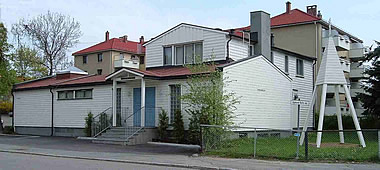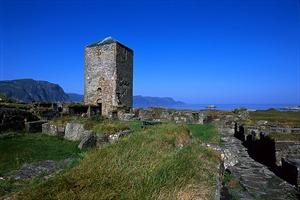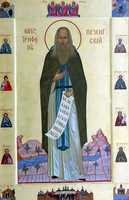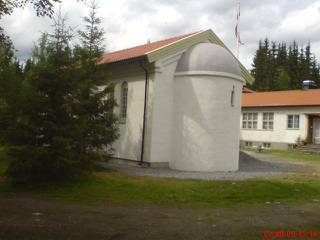
This year, I had the blessing to visit my ageing relatives in Norway, along with the elder of my sisters and her husband. The last visit to them had been about thirteen years ago. Since then, some first-cousins had already reposed; others are nearly ninety years of age. These persons are great-grandparents, and some are nearing the possibility of seeing yet another generation. It was a good thing to visit now, and I am glad my sister insisted, since I have no idea when, or if, I may have the blessing to visit again. Of course, I said I would return as soon as possible, but I said the same thirteen years ago. Life is unpredictable.
Much of my time was spent in talking with these very relatives, and their children, and grand-children, and this in an odd mixture of English, French, and three kinds of Norwegian. There are a few details about which one might write, to share with others. There is the nature of the Orthodox Church in Norway, and there is the increase of the devotion to St Sunniva.

The last times I had visited Norway, the Orthodox Church subsisted mostly in Oslo, with some little activity beyond. At that time, any activity beyond stemmed from St Nicholas' Church in Oslo (which began in the 1920s with Russian émigrés, who in time came under the “Paris Jurisdiction”, the Russian Diocese of Western Europe, of the Ecumenical Patriarchate, currently under the Archbishop of Paris, GABRIEL). There was, and is, for at least thirty years, a Monastery north of the city. This is the residence of the now Archimandrite Johannes (Johansen), and two other monks. A bit more recently there arrived a number of Greek-speakers, who established a Greek parish, which is under obedience to the Metropolitan of Stockholm, PAVLOS. Then there arrived a new Russian-speaking immigration, and also Serbs, and Romanians, and now many Ethiopians, Eritireans, and Copts. Regardless, all of these more recently-arrived had their beginning in, and from the Church of St Nicholas. From the time of the beginning of the service of Archimandrite Johannes, a graduate of the Insitut St-Serge de Paris , the focus of this parish, and the monastery in Hurdal, has been developing the use of the Norwegian language, and attempting missionary work. This is particularly difficult in the Norwegian environment, so much formed by the Lutheran State-Church. Nevertheless, there are now established communities in places like Bergen, Stavanger, and other places, as reported on the web-site of St Nicholas. Now, in Oslo, there is a parish established directly under Moscow, with its own set of missionary parishes throughout Norway. There is also a Serbian parish, and a Romanian parish besides the original St Nicholas. All of these Churches are generally invisible to most Norwegians, in comparison to the increasingly numerous, and increasingly vocal Muslim. To Islam, there are now many Norwegian converts, particularly among young women who marry Muslim men. There is a substantial immigration from Africa. Our St Nicholas Church began in a house, and then in a basement of a Lutheran Church in western Oslo. That basement Church remains a part of this parish's life. But since my last visit, the Church has also bought, and taken over what used to be a grocery-store in eastern Oslo, in an area where more new immigrants live. I was surprised to see that it is just across the street from the apartment in which my recently-deceased cousins used to live. The store has converted well into a small, but visible, above-ground temple. When we were there, there was an absence of many parishioners, since July is vacation month in Norway. Nevertheless, there were still many in Church, and the singing and serving were pleasant. Archbishop GABRIEL of Paris had given the blessing that I serve there. In addition to all this, I considered it a particular blessing to have been told that the principal Icon of Christ on the Iconostasis has been giving myrrh regularly, and continually for ten years already. Indeed, it was noticeable when I was there.
It is important to note that the decline of the Norwegian Lutheran Church, that had been well-known about in the past, has been accelerating. There are fewer, and fewer clergy, and very few people now seem to attend Church, except at Christmas (Pascha is now mostly for skiing). This State-Church seems to have been reduced to being for the most part a socially-active entity that is disconnected from the people. One of the cousins, of contemporary age to me, lamented the fact that, although when she travelled abroad, she could, and did go into many Roman Catholic and Orthodox Churches, and did light candles with praying, she could not do so anywhere in Norway. Her opinion was supported by another, somewhat younger cousin. Indeed, the Churches in Norway are, as in North America, locked outside service-times (except for the historic ones, for which there is a charge to enter, and a guide, but no candle-lighting). Norwegians are well-known for their social responsibility, and for their concerns about promoting peace, and so forth. All this is rooted in their Christian ancestry, but it is deliberately ignored in the context of humanism. I was rather saddened to be told that in my family's village, a circuit priest comes every three weeks, and only about 12 persons now attend (except at Christmas). It seems that even some urban Churches suffer the same shortage of clergy, and of congregations. Some years ago now, the Swedish Lutheran Church disconnected itself from the State in Sweden, and now lives on its own resources, rather than the State Subsidy through taxation. I have myself heard nothing about such a movement in Norway, but the apparent paralysis of this Church in Norway could, in my opinion, find some way towards renewal by doing something similar. Of course, it is easy to make such critical comments from outside. At the same time, in Vestland, in Nordfjord, I am told that there are now many Russian-speaking women, who have married Norwegian men. This particular fjord is certainly not at all a centre of vitality, but rather a rather remote, and somewhat struggling community. This remoteness has generally been the case, except in Viking and Hanseatic times. In contrast, the Roman Catholic Church, which has been small, is very noticeably growing. It seems that many Lutherans will recognise their Roman Catholic history, which is generally popularised, in comparison with the connexion with Rus' which is very clearly addressed in the Sagas. Indeed, it was the Rus' connexion that gave Christianity's permanent roots in Norway, not the British one, as is so often wrongly repeated. One of the signs of this, apart from Constantinopolitan iconographic styles in early murals, and some architecture, is the fact that clerical celibacy as required by Rome was never able to be established before the Reformation. Of course, afterwards, there was no such requirement.
Another detail not discussed directly by my relatives is the activity of the Pentecostals. They are present in their various halls, and they had their beginnings, I understand, in Norway over a century ago. It is no wonder that other alternatives are being tried, or that people have withdrawn into themselves, since so many complain about the Calvinistic disposition of many Lutherans in Norway. Among those who are active, as Lutherans, the tendency is to be pessimistic, and negative about human behaviours, and to be living in an atmosphere of guilt, and condemnation. There is very clearly a disposition, as in North America, of a “consumer-style” approach to the Church. The lack of sense of “absolute Truth”, and the current, prevalent egocentric relativism contributes greatly. Further, it has been interesting to see how, as in other places, when there is an abandoning of the traditional Christian way of life, and the importance of the worship of the Lord, there immediately arrives superstition to take its place. There is in Norway, also, some sort of a pagan revival, with nostalgia for “the good old days”. Regardless of all these comments, and although all is very slow-moving (not so different from Canada), there are many Norwegians who have an appreciation for Orthodoxy.

St Sunniva, the martyr of Selja Island, with her companions, at about AD 960, has now become quite popular in Norway. During my last visit, she had begun to be better known, although the Nordfjordites had always been aware of her. The spring/well at the Monastery ruins, for instance, has been known for a long time to be beneficial, and healing. The water is very fresh, cool, and also aromatic. However, because of Lutheran resistance to saints, there grew up instead a superstitious attitude to this spring, in part, I suppose, to protect it. Now, people are told that if one kneels to drink, and takes the water to the mouth in the right hand, and also washes the face with the right hand, then one will become younger. We made a pilgrimage to this island during the visit to Nordfjord. Even from halfway down the fjord, as is our family's village of Stårheim, it takes at least an hour to drive to the town of Selje, over the new, and improved roads, and thence by a small boat for 15 minutes to the island. The remains of the Benedictine monastery that grew up in the 11th Century near St Sunniva's cave are still quite visible, and in part being restored. The steps up to the cave are many, and very difficult to manoeuvre. There is now an Icon of Christ at the place where St Sunniva's uncorrupt body was found, and rested for more than a century. There are now annual pilgrimages in July for the Feast-day (both Roman Catholic, and Orthodox), and there are cultural festivals associated with St Sunniva. Her name, and image are now associated with the county of Selje, and her name has also become rather commercialised, being found as a brand-name on soaps, and fruit-juices.


We made a pilgrimage with one cousin to the Skete of St Trifon (of Pechenga), some 90 km north from Oslo, and the residence of Archimandrite Johannes (Johansen). He is also Dean of Scandinavia for the Archdiocese of Paris, under Archbishop GABRIEL. This skete is situated in a remote area of Hurdal, among hills and forests not unlike either Trans-Carpathia or Bukovinian Romania. It was previously situated in an even more remote area, but for the last ten years has been at the present site, easily accessible from a not-busy highway. The main building is a former school, which accommodates the small community very well. Nearby is a small log-built chapel to St Seraphim of Sarov, built in a rural Norwegian style. Almost completed is a stone-construction Church, near the entrance, and close to the main building. Everything is built with ecology in mind, and recycling as well. The style of this Church is a near-copy of a Church in Kosovo, and it is purposely built “in solidarity” with the Serbian Church there. The monastery is the supporter of the main missionary, and publishing work in Norway. From here, also, is served annually the small chapel in Neiden, North Norway, which was built by St Trifon of Pechenga (Petsamo), about 500 years ago. The conversation with Archimandrite Johannes (whom I have known since 1980) was very frank in terms of the similar sense of missionary purpose that we share as North Americans, and as Norwegians.
The unworthy
+SERAPHIM
Archbishop of Ottawa, and of Canada
.
.